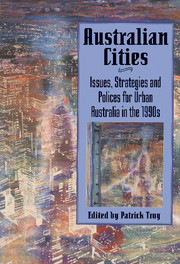Book contents
- Frontmatter
- Contents
- List of Figures
- List of Tables
- Preface
- Acknowledgements
- Note on Contributors
- Abbreviations
- Introduction
- Part I The Development and State of Australian Cities
- Part II Current Policies and Options
- Part III Avenues for Development
- 10 Financing Urban Services
- 11 Alternative Urban Policies: The Case for Regional Development
- 12 Cooperation Between Governments
- References
- Index
10 - Financing Urban Services
Published online by Cambridge University Press: 03 May 2011
- Frontmatter
- Contents
- List of Figures
- List of Tables
- Preface
- Acknowledgements
- Note on Contributors
- Abbreviations
- Introduction
- Part I The Development and State of Australian Cities
- Part II Current Policies and Options
- Part III Avenues for Development
- 10 Financing Urban Services
- 11 Alternative Urban Policies: The Case for Regional Development
- 12 Cooperation Between Governments
- References
- Index
Summary
Questions about the funding of urban infrastructure have become more topical in recent years as governments providing infrastructure have sought to limit their financial commitments. The evidence of the cutback in public investment is clear. Real gross fixed capital expenditure by the public sector was the same in 1991–1992 as in 1984–1985 and fell from 6.6 per cent to 5.5 per cent of Gross Domestic Product (GDP). For public enterprises, which are very largely concerned with provision of infrastructure, there was a fall of 6 per cent in real gross fixed capital expenditure over the same period.
One reason is a change in the prevailing economic orthodoxy in the government, and another is the recession. As a result of the former, revenue from taxes, fines and fees fell from 30.7 per cent of GDP in 1984–1985 to 30.2 per cent in 1991–1992. As a result of the latter there was an increase in government expenditure on personal benefits from 9.9 per cent of GDP in 1984–1985 to 11 per cent in 1991–1992, and real GDP, which had risen by 20.5 per cent between 1984–1985 to 1989–1990, was lower in the following two years.
One of the planks of the increasingly neoclassical policies followed by government since 1980 is a reduction in the size of the government sector, because of a belief that lower taxes will stimulate private investment.
- Type
- Chapter
- Information
- Australian CitiesIssues, Strategies and Policies for Urban Australia in the 1990s, pp. 220 - 245Publisher: Cambridge University PressPrint publication year: 1995
- 5
- Cited by



